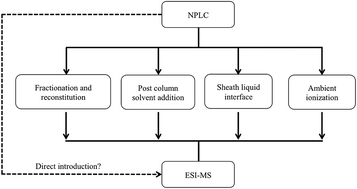Coupling normal phase liquid chromatography with electrospray ionization mass spectrometry: strategies and applications
Abstract
Normal phase liquid chromatography (NPLC) is widely applied in the analysis of lipids, plant extracts, chiral molecules, and petroleum. NPLC alone is not powerful enough to handle the complexity of some samples. Electrospray ionization mass spectrometry (ESI-MS) coupled with NPLC enables characterization of complex samples. However, the mobile phases commonly used in NPLC are not compatible with ESI-MS due to their low polarity and dielectric constant. There are five pathways for coupling NPLC with ESI-MS. In limited cases, where the NPLC eluent contains significant quantities of polar solvents, the eluent can be directly introduced into the ESI-MS. More commonly, NPLC effluent fractions are collected and reconstituted off-line in an ESI-compatible solvent. Alternately, there are three emerging on-line approaches that enable direct coupling of NPLC and ESI-MS. A make-up solvent that is ESI compatible can be added through a T union or sheath liquid interface to the NPLC effluent to generate a stable ESI spray. Alternatively, analytes separated by normal phase TLC plates can be sampled into ESI-MS by ambient ionization techniques. This review discusses the five strategies for hyphenation of NPLC with ESI-MS and the application of NPLC-ESI-MS for lipids, enantiomers and fuel analysis. The comparison between different strategies for NPLC-ESI-MS is also briefly discussed.


 Please wait while we load your content...
Please wait while we load your content...